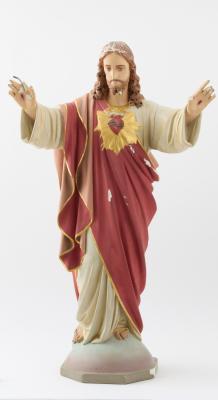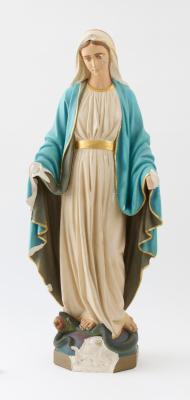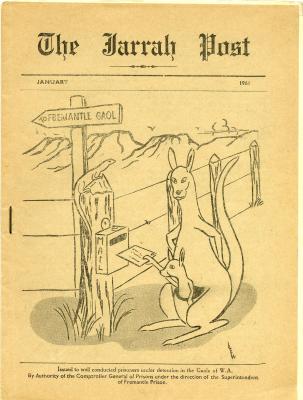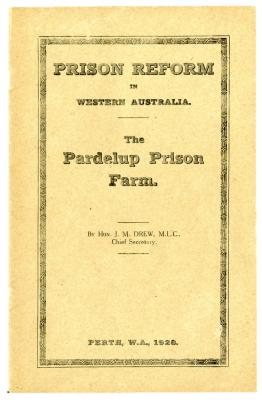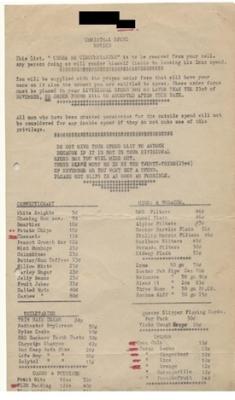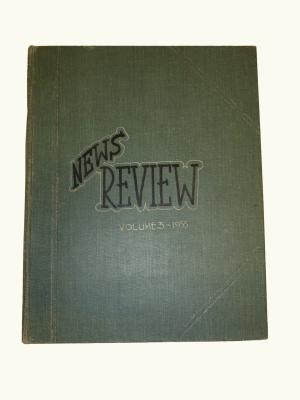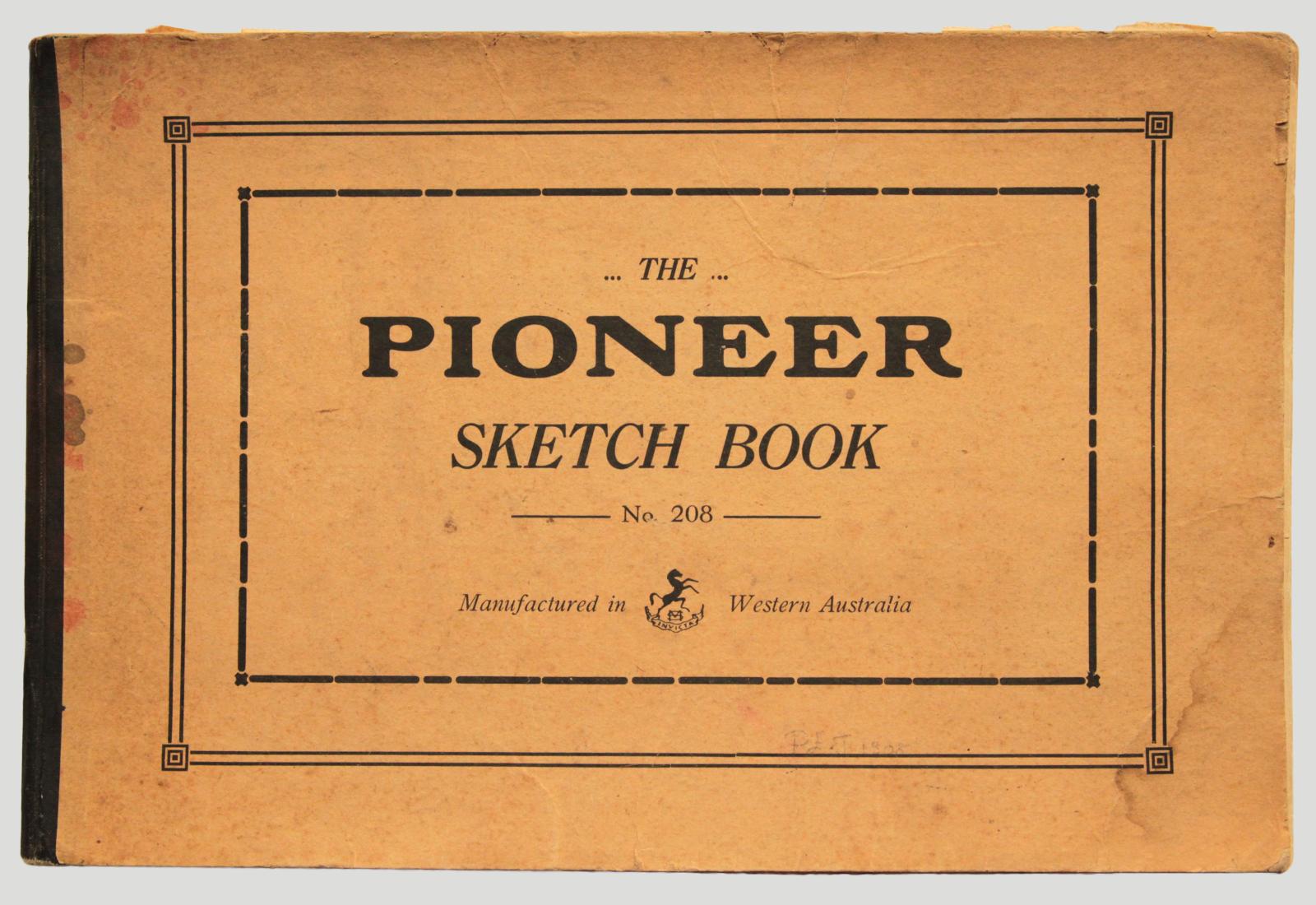SKETCHBOOK
1943Large, brown, Pioneer brand sketchbook, holding 10 bound sheets of white cartridge drawing paper between cardboard covers. The sketchbook is titled 'THE/PIONEER/SKETCH BOOK/ No.208/ Manufactured in Western Australia'. Hand printed in pencil is, 'PEJ 1308'. Artist used the initials/pseudonym P E J. Inside of front cover contains a poem beginning 'And what if yesterday we went to Goal' signed P E J. Each page of white cartridge paper contains drawings and a hand printed poem signed P E J. Illustrations done in pen and ink.
The first illustrated poem is titled 'VD' and has an illustration on either side of text of a sailor (left side) and a young woman (right side) holding onto a chains with both hands.
The second illustrated page has two poems one titled 'BECAUSE' with an illustration of a woman's face appearing behind bars. The second is titled 'THE YANK' and has an illustration of a sailor.
The third illustrated page has a poem titled ' THE FREMANTLE GUEST HOUSE' and has an illustration of a stone wall and gate.
The fourth illustrated page is a continuation of the poem 'THE FREMANTLE GUEST HOUSE' and has an illustration of a female prisoner on her bed titled 'Breakfast in Room 16' .There is a second illustration of a clothesline with prisoner clothing hanging on it . This is titled ' The Austerity wardrobe adopted by the guests'
The fifth page has a poem titled 'THAT BELL' with an illustration of a matronly woman ringing a bell.
The sixth page has an poem titled ' Mary' with an illustration of a woman with mop and bucket.
The seventh page has a poem titled 'ANXIETY of Amy' and has an illustration of two sailors pulling a baby in opposite directions.
The eighth page contains a poem titled 'Short Shirted' and contains a picture of a woman reclining on a bed.
The ninth page contains a poem titled 'Why Worry' and has an illustration of a woman bending over a bathtub as well as an illustration of a woman in bed being attended to by a doctor.
The tenth page contains a poem titled ' It Wont Be Long' and has an illustration of a woman in her underwear on the left of text and a woman in fine clothes and heels on the right.
The donor found this artefact at a rubbish tip in 1987. The PEJ sketchbook offers an alternative view of female inmates, challenging many of the popular discourses about criminal women in the mid-twentieth century. The sketchbook contains 10 pages of illustrated poems, dealing with social attitudes and conditions in the Female Division during the 1940s.
The author of this work was originally identified as Audrey Laurel Cecelia Pearson, by what was believed to be the author’s prison number, which accompanied the initials ‘P. E. J.’ on the front of the book. However Pearson’s dates of incarceration did not fit with a date recorded inside of the book, “Fremantle 1943”. It is now believed that the author of this work is Patricia Elenor Jakins, an inmate at Fremantle Prison during the 1940s, both of whose dates of incarceration, and initials, fit with the author’s.
Details
Details
'PIONEER'
In 1942 Patricia Elenor Jakins was sentenced to three months imprisonment for being idle and disorderly. Specifically, she was charged and convicted on the grounds that she had no visible lawful means of supporting herself. This was one of eight sentences she would serve in Fremantle Prison. It is believed that it was during her incarceration in 1943 that she created this sketchbook. Jakins’ observations of everyday prison life show a stark alternative to the domestic depictions offered by the media of the time.
During the initial construction of the Convict Establishment there were no plans to include a female division. This had to change in 1886 when the site ceased to be for the exclusive use of convicts, and was handed over to the Colonial Government. In 1887 it was recommended to the Colonial Secretary that all prisoners from Perth Gaol be transferred to Fremantle Prison, including the women. The female prisoner population at this time was relatively small, with an average of between 12 to 16 individuals on any given day, most of whom were serving short-term sentences. So in 1889 the north-west corner of Fremantle Prison was walled off and became the basis for the new Female Division (Women’s Prison). The buildings which had been housing the kitchens, the bakehouse and the washhouse since the beginning of the Convict Establishment were transformed for use by the female prisoners. Initially, the Women’s Division included 16 cells, a bathroom, a lying in room, an association room, two kitchens, the Matron’s quarters and a storeroom. In 1895 the first floor of a new wing was built, containing 22 additional cells, another bathroom, day room, hospital, chapel and lying in room. By 1909 a first floor level had also been added, containing a further 24 cells.
Conditions for female prisoners were intermittent, and all too frequently dependent upon a social belief that as females they would respond to minimal interventions, such as pastel colours for the décor and lighter uniforms. In 1911 the Superintendent of Fremantle Prison, Hugh Hann, was moved to describe their environment as ‘harsh to a degree’ and the female prisoners as ‘fallen’ women. Their work was limited to knitting socks, dressmaking and the tough laundry work. On 13 March 1970 the Female Division of Fremantle Prison was vacated, and all female prisoners were relocated to the new Bandyup Rehabilitation Centre.

